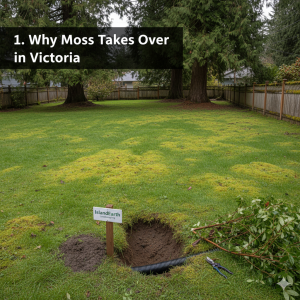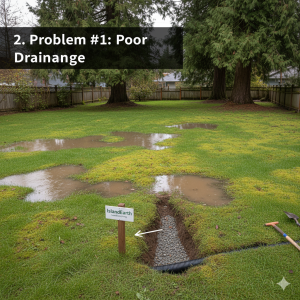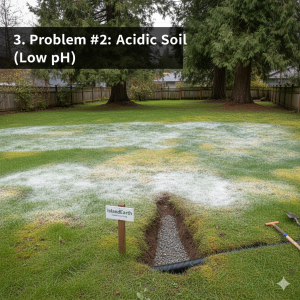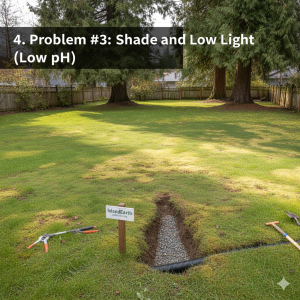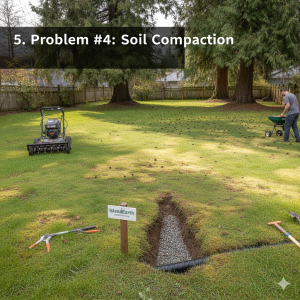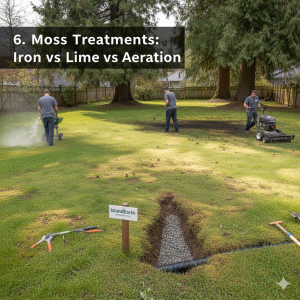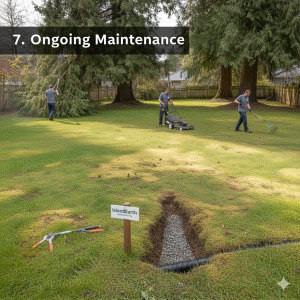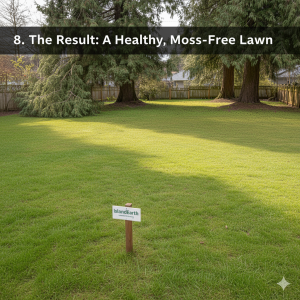Q + Short Answer:
Moss spreads fast in Victoria’s rainy fall months when lawns stay damp, acidic, and shaded. The real fix isn’t just moss killer—it’s improving drainage, adjusting soil pH, increasing sunlight, and restoring grass health through aeration and overseeding. Act now, before October rains give moss another head start.
1. Why Moss Takes Over in Victoria
Moss thrives where grass struggles: wet, compacted, and low-light conditions. With Victoria’s mild, rainy climate and clay-heavy soils, those conditions are common—especially in shaded or north-facing yards. Once fall moisture returns, moss can spread across lawns in weeks.
IslandEarth example: In Saanich, our crew found heavy moss under cedar trees. After adding a simple French drain and pruning branches, the grass began filling in by spring.
2. Problem #1: Poor Drainage
What it is
Water pooling on lawns deprives roots of oxygen and gives moss a perfect foothold.
Why it matters
Victoria’s clay soils hold water after rain. Without proper grading or drainage, lawns stay soggy through fall and winter.
Fix: Install French drains, regrade low areas, or add compost and sand to improve soil structure.
IslandEarth example: On a Colwood property, trench drains redirected runoff from a slope. Moss vanished by spring.
3. Problem #2: Acidic Soil (Low pH)
What it is
When soil pH drops below 6.0, grass weakens—but moss thrives.
Why it matters
Frequent rain naturally acidifies soil in Victoria. The BC Government Horticulture Guide notes that moss often signals acidic, nutrient-poor soil.
Fix: Apply dolomitic lime to raise pH and strengthen turf.
IslandEarth example: A Victoria lawn with a pH of 5.2 improved dramatically after a fall lime treatment, with thicker, greener grass by spring.
4. Problem #3: Shade and Low Light
What it is
Grass needs 4–6 hours of sunlight daily, while moss grows happily in deep shade.
Why it matters
Older neighborhoods like Oak Bay and Fernwood have mature trees and buildings that block sun. In these spots, moss always wins without light adjustments.
Fix: Thin or prune branches, or choose shade-tolerant turf blends like fine fescue.
IslandEarth example: After canopy thinning in Oak Bay, sunlight reached the soil again—and moss quickly receded.
5. Problem #4: Soil Compaction
What it is
Compacted soil limits air and water flow, suffocating roots.
Why it matters
Victoria’s heavy clay compacts easily under mowers and foot traffic, encouraging moss and puddling.
Fix: Schedule core aeration each fall to relieve compaction and overseed thin patches.
IslandEarth example: In Langford, aeration followed by overseeding turned a mossy lawn into thick turf within one season.
6. Moss Treatments: Iron vs Lime vs Aeration
| Treatment | Purpose | Best Time | Pros | Local Use |
|---|---|---|---|---|
| Lime | Raises pH | Fall or spring | Long-term fix | For acidic soil (pH <6) |
| Iron (Moss Killer) | Kills moss fast | Fall or early spring | Quick but temporary | For visible moss patches |
| Aeration | Relieves compaction | Sept–Oct or spring | Improves soil health | For heavy clay lawns |
According to BC Living, using iron sulfate is most effective after correcting soil and light issues. Otherwise, moss will return once the soil stays damp again.
7. Ongoing Maintenance
Even with proper drainage and pH, moss can return without consistent care:
-
Prune trees for light
-
Mow grass higher (3–4 cm)
-
Avoid overwatering
-
Rake or dethatch yearly
-
Fertilize lightly each spring
Healthy, dense turf naturally resists moss invasion.
IslandEarth example: On a Victoria strata lawn, our team performs annual aeration and canopy thinning. Moss hasn’t returned in three years.
Mini FAQ
Q: Should I rake moss before or after treatment?
After—wait about 10 days for moss to blacken before removal.
Q: How often should I lime?
Every 1–2 years depending on rainfall and soil test results.
Q: Can moss ever be left as-is?
Yes, in deep shade or low-traffic areas—but it won’t tolerate wear.
Quick Checklist
-
Test soil pH (target 6.0–6.8)
-
Improve drainage and grading
-
Prune trees for better light
-
Core aerate compacted soil
-
Apply lime or moss killer if needed
-
Overseed thin spots
-
Maintain mowing and fertilizing
🌱 IslandEarth CTA
IslandEarth can handle aeration, drainage, lime, and overseeding in one visit. Book your free site check anywhere in Greater Victoria.
Moss in Victoria lawns is a symptom of underlying issues—poor drainage, low pH, and limited sunlight. The solution is to strengthen your soil, not just kill moss. With aeration, lime, drainage fixes, and consistent maintenance, your lawn can stay green and moss-free—even through the Island’s rainy seasons.
